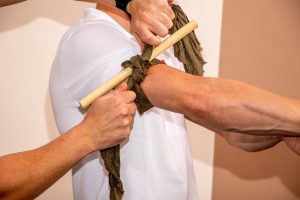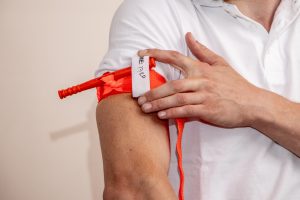*Tourniquets*
What is a tourniquet
A tourniquet is a band or strap that is wrapped very tightly above a wound to an arm or leg to apply pressure and stop severe bleeding. It should only be used for life-threatening bleeding that cannot be stopped by applying direct pressure.
Tourniquets can be purpose-designed or improvised and both can be effective so long as they are applied and monitored correctly.
Inappropriate or prolonged use of tourniquets can lead to nerve and tissue damage and circulatory complications.
A First Aider should attend practical training to learn how to apply a tourniquet safely.
Manufactured Tourniquet
Most manufactured tourniquets consist of flattened fabric with a clasp or buckle, a windlass and a clasp to hold the windlass.They may also have a label where you can make a note of the time the tourniquet was applied
Improvised Tourniquet

To make an improvised tourniquet you will need:
- A makeshift band long enough to go round the wound at least once and at least 4cm wide to prevent damage to nerve tissue. This could be a triangular bandage, scarf or other piece of clothing
- A makeshift windlass to tighten the tourniquet and stop the bleeding such as a pair of strong scissors, a piece of cutlery or a stick
Applying a tourniquet - Step by Step
- Apply the tourniquet directly to the skin, 5-7 cm above the source of bleeding
- Make sure the tourniquet is around a part of the limb that is between the source of bleeding and the heart. For example, if the wound is on the forearm, apply the tourniquet to the upper arm. Avoid placing it over the knee or elbow joint
- If it is not possible to expose the skin, wrap the tourniquet over the top of the clothing. If clothing or other items bunch up when trying to wrap the tourniquet around them, flatten them out as much as possible
- If the casualty is conscious, tell them that the following step may be very painful
- Twist the windlass on the tourniquet gently to the right to further tighten the tourniquet. Turn the windlass until the bleeding stops
- Once the bleeding substantially slows or stops, secure the windlass by attaching it to the windlass clip on the tourniquet. If the tourniquet has a velcro strap, wrap it around the windlass to further secure it
- Make sure someone has called 999/112 for emergency help
- Take note of the exact time the tourniquet was put on by writing on the tourniquet itself, or on the casualty's body or by recording it on a phone or device. If a tourniquet is left on for too long, nerve and tissue damage can occur.
- Continue monitoring the bleeding
- If the casualty is conscious, reassure them and try to keep them awake
- When the emergency services arrive, let them know how long the tourniquet has been in place
NEVER be tempted to loosen or remove a tourniquet. Once applied, the removal of tourniquets should only ever be done by a medical professional

